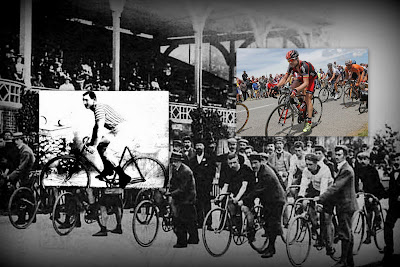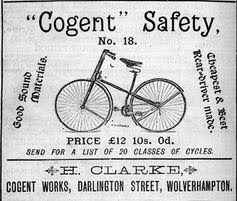BIKE RACING ACROSS THE CENTURIES
Cycling has come a long way since the 1890’s, or so I thought. But then. looking back on the career of a young man from the ghost town of Hillgrove I found it hadn’t really changed at all...well not all that much.
*
Such was the furore surrounding this new craze it didn’t take very long at all before cycling entered the realm of competition. And that’s where William Davison enters the story.
THE HILLGROVE QUAD
In a previous story I wrote about the town that disappeared*... Hillgrove, and the days my paternal grandparents lived there. At the same time I uncovered stories about a local cycling hero, William Davison whose prowess and love affair with a bicycle brought him fame and publicity along much the same lines as Cadel Evans and the Tour de France cyclists of today.
In Australia in the years before the turn of the century cycling as a sport was just emerging. Still in its infancy; but in a Sydney newspaper article from 1896 I found a curious parallel between William Davison and the riders of today’s Tour.
‘Walter Sanger, the crack American, is called the ‘Quad’ because he does all the donkey work in the races. He sprints up to a field like a locomotive and generally takes some one up to him who beats him home. Davison by somewhat similar tactics has in Sydney earned the sobriquet of the ‘Hillgrove Quad’.
Inquirer and commercial news Perth fri 27 Nov 1896
Sounds familiar doesn’t it? The same manoeuvre repeated constantly to great effect throughout today’s Tour.
William Davison was born in Armidale in1876 to a Scots father and an English mother, and moved to Hillgrove in his early teens to work in the Eleanora and Bakers Creek gold mines. It was a fortuitous move for young William and though he found fame and prizes in southern cities he continued to call Hillgrove home for the next 30 years.
The champion rider was a modest young man, he gave few interviews. He loved riding bikes and for ten years or so archived newspaper clippings are all that really remain as evidence of his skill and success during those years.
In a much later interview published in the Armidale Express in 1946 he told a reporter, “I did a lot of riding on the roads, we had no cars or motor bikes back then and we went everywhere by push bike. Once when my wife was very sick and the coaches were late, I rode to Armidale and out again to Hillgrove with a 25 pound block of ice in 80 minutes.”
*
A family story recalls a visiting Sydney businessman was so impressed by the young man’s energetic work pushing the mine carts, that he financed the purchase of a racing bicycle. That year 1895 saw the beginning of his cycling career.
Hillgrove was a booming centre at the time with a racing track and recreation grounds attracting regular crowds of 3000 patrons. It wasn’t long before the young Hillgrove wheelman began competing in nearby towns, Glen Innes, Armidale, Tamworth and Emmaville. When William won the complete programme of six events at Emmaville against strong fields he was urged to compete in national events in Sydney.
The Winter Race Meeting of the League of N.S.W. Wheelmen in Sydney on the 15th of August 1896 saw the beginning of young William’s racing fame. His name wasn’t mentioned in advertisements leading up to the meet, but by the end of the day his name would be flashed to newspapers throughout Australia and New Zealand.
A Sydney newspaper reported proceedings... ‘At about 3 o’clock Lord Hampden accompanied by two of his daughters and son, arrived on the grounds , was received by the President of the League, Mr T. Hassall M.L.A. The Vice Regal party remained on the grounds for some time watching the race.
The rain, which had so persistently hung about all day broke during the running of the final of the Hampden Wheel Race, but not withstanding this the race proved a most interesting and exciting one, and the win of W. Davidson of Hillgrove was a deservedly popular one, the manner in which he wore the field out stamping him a superior rider.
In a New Zealand report on the race, the news item mentions the only win of the day by a countryman, Ken Lewis who won the Championship of New South Wales. Lewis, the article reported also contested the Hampden Wheel but failed to ride a place in the event won by W. Davison.
Within a few days of his win, on the 21st August 1896, William Davison’s name would join other crack cyclists... the American Martin, New Zealander Lewis, and Australians Meadham and Clinton... in advertising leading up to Sydney’s Grand International Cycling Carnival.
Davison went on to more wins and even more praise for his speed and riding skill. At the Sydney Cricket ground he teamed up with the famous Wheelmen Ossie Prouse, Don Harvison, Fred Prouse and Don Mutton in a multicycle race they won with a world record time of 1.27 for the mile. The multicycle was a novelty machine seating five riders who pedalled for their lives.
‘We rode the big machine in Sydney streets and got hooked up in traffic,’ he told reporters.
Four and five man multi-cycles of the day
*
Around this time I was surprised to find a newspaper story with yet another Aussie parallel to the Tour de France. Thumb tacks had been strewn across the road in the path of a Goulburn to Sydney road race. The year was 1896. Fast forward to the mayhem caused on the 2012 stage when the peloton in a great display of sportsmanship slowed their progress to allow cyclists to repair their bikes and continue the race.
It seemed such hooliganism has been around for a long, long, time.
*
In the 1946 interview in the Armidale Express William wouldn’t draw comparisons between riders of his day and those of the 20th century but he did say the old timers were handicapped by the heavier cycles and the low gear ratio.
“We pushed the old machines with 60 to 70 gears, now they push a machine which is like a skeleton, no weight at all and their gears are over 100. One thing I will say, I think the cyclists of today would do better if they trained on the roads on big heavy machines with the 60 to 70 gears. Then when they went on to the track with the light machines, they would simply fly.”
The following years saw Davison featuring in and winning even more races.
A grudge match with a £100 purse was set up between him and long time rival R. Stanfield from Tamworth. William won the race. His name and reputation now featured as a major draw card at future carnivals.
In 1898 William married his sweetheart May Edwards. In the four years of their marriage they had three children before May died in 1902. He opened a bike repair shop in Hillgrove about that time but gradually his name disappeared from major cycling events.
He continued to race in local and nearby events into the early 1900’s and in 1906 William Davison married Esther Day.
*
If William Davison were alive today I wonder how he would react to the hype and publicity surrounding the Tour de France, the constant travelling to other races in countries all over the world by modern day cycling stars; to the glory and hullaballoo and the huge prize money on offer...
...a world and a lifestyle away from Hillgrove ... and that 80 mile round bike trip to fetch a block of ice!
***
Robyn Mortimer ©2012






























